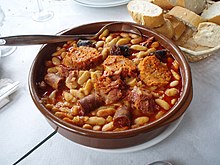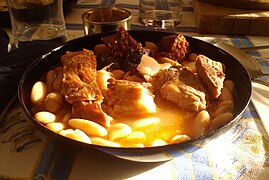food.wikisort.org - Dish
Fabada asturiana, often simply known as fabada, is a rich Asturian bean stew, originally from and most commonly found in the autonomous community of Principality of Asturias, but widely available throughout the whole of Spain and in Spanish restaurants worldwide. Canned fabada is sold in most supermarkets across the country.
 Fabada Asturiana | |
| Alternative names | Fabada |
|---|---|
| Type | Stew |
| Course | Appetiser or main course |
| Place of origin | Spain |
| Region or state | Principality of Asturias |
| Serving temperature | Hot |
| Main ingredients | White beans |
| Variations | Olla podrida, cassoulet |
Fabada is a hot and heavy dish and for that reason is most commonly eaten during winter and as the largest meal of the day, lunch. It is usually served as a starter, but may also be the main course of the meal. It is typically served with Asturian cider or a red wine.
Ingredients
Fabada is made with fabes de la Granja (a kind of large white beans from Spain) soaked overnight before use, lacón (shoulder of pork) or pancetta or bacon (tocino), morcilla (a kind of Blood sausage from Spain), chorizo, olive oil, sweet paprika, garlic and salt. [1][2]
History
The consumption of "fabes" goes back in Asturias to the 16th century, in which it is known with certainty that they were planted in the territory and consumed. The variety used in fabada is called "de la Granja", it is a smooth and buttery variety appropriate for this dish. The cultivation of this variety occupies about 2,500 hectares in Asturias. The ingredients of the fabada recipe reveal a humble origin. Scholars think it may have been born in the 18th century, although there is no evidence to support this. Despite the fact that fabas are a purely rural ingredient, the belief that fabada is born in the cities is maintained. There are no written literary references to fabas in any of the works of the time. One of the best known, La Regenta, does not mention it despite making an exhaustive description of the customs of the region. Other authors mention its resemblance to the Languedoc cassoulet from French cuisine that could have reached Spain thanks to the Camino de Santiago via the French route in the Middle Ages.[citation needed]
The first written reference to fabada appears in the Asturian newspaper of Gijón El Comercio in 1884 but does not mention the recipe. Later appearances in Asturian culinary literature relate the dish to the Asturian pot, authors such as Armando Palacio Valdés when describing the characteristics of Asturian shepherds in his work "Pastoral Symphony" (1931) does not mention the dish. According to the research of different experts, fabada is born in an undetermined period between the 19th and 20th centuries. Some authors lean more towards the twentieth century, but today it is already a well-known dish, not only in Asturias but throughout the Spanish territory. Recipes appear in the literature of the beginning of the century.
Asturian emigrants around the world noticed this dish in other places, in this way there are variants of this dish in some places, such as in the areas near the American city of Tampa.
In Colombia, the paisa tray is a Creole adaptation of the fabada, replacing the fabas with red ball beans (soaked for 16 hours) cooked with pork leg, garlic onion and salt, accompanied by chorizo, pork rinds, cooked ground meat, fried egg, sliced avocado and white rice.
Variations
Outside Asturias, the Spanish olla podrida, southern French cassoulet, and Brazilian feijoada are similar to fabada asturiana.
Images
- A prepared fabada
- Fabada prepared in a traditional clay cazuela
- Fabada prepared with the traditional recipe
- Accompanying meats with the fabada
See also
- Baked beans
- Cassoulet
- Common bean (Phaseolus vulgaris)
- Feijoada
- List of pork dishes
- List of stews
- Olla podrida
- Pork and beans
- Fabes con almejas (cookbook entry)
References
- http://www.spain.info/TourSpain/Gastronomia/Productos%20y%20Recetas/Recetas/C/0/Fabada.htm?Language=en%5B%5D
- "Fabada asturiana". Archived from the original on 2008-11-10. Retrieved 2008-11-16.
- References in Spanish Wikipedia
- Aris, Pepita. Spanish: Over 150 Mouthwatering Step-By-Step Recipes. London: Anness Publishing Ltd, 2003. p 203.
- Chandler, Jenny. The Food of Northern Spain. London: Pavilion Books, 2005. p 95.
- Klöcker, Harald. Culinaria Spain. Cologne: Könemann Verlagsgesellschaft mbH, 1998. p 208.
На других языках
- [en] Fabada asturiana
[es] Fabada
Fabada asturiana, o simplemente fabada, es el plato tradicional de la cocina asturiana elaborado con faba asturiana (en asturiano, fabes), embutidos como chorizo y la morcilla asturiana, y con cerdo. Es el plato típico de Asturias (el plato regional más conocido de la región asturiana), pero su difusión es tan grande en la península ibérica que forma parte de la gastronomía de España más reconocida. Se considera según ciertos autores una de las diez recetas típicas de la cocina española.[1] Es un plato invernal con un volumen alto en calorías y grasa que se sirve caliente a mediodía (almuerzo),[2]. Probablemente la fabada empezó a consumirse en Asturias desde el siglo XVI aunque no se encuentren referencias escritas de ella hasta el siglo XIX, en distintas notas de prensa de un diario gijonés en el que se la menciona como un plato popular asturiano.[ru] Фабада
Фаба́да (исп. fabada) — традиционное и самое известное блюдо астурийской кухни, представляющее собой густой калорийный и жирный суп из белой астурийской фасоли с беконом, окороком и колбасой — обычно чорисо и слегка подкопчённой астурийской морсильей. Название блюда произошло от астурийского слова fabes, означающего «фасоль». Красноватый цвет фабаде обеспечивают паприка и шафран. Фабада готовится на медленном огне в течение нескольких часов. Набор мясных ингредиентов добавляется в блюдо в последний момент. Считается, что фабада, как и вчерашние щи, вкуснее на следующий день. Астурийцы едят фабаду зимой на обед. К фабаде подают сидр, пиво или вино. В Испании готовая к употреблению фабада продаётся в супермаркетах в консервных банках.Другой контент может иметь иную лицензию. Перед использованием материалов сайта WikiSort.org внимательно изучите правила лицензирования конкретных элементов наполнения сайта.
WikiSort.org - проект по пересортировке и дополнению контента Википедии



